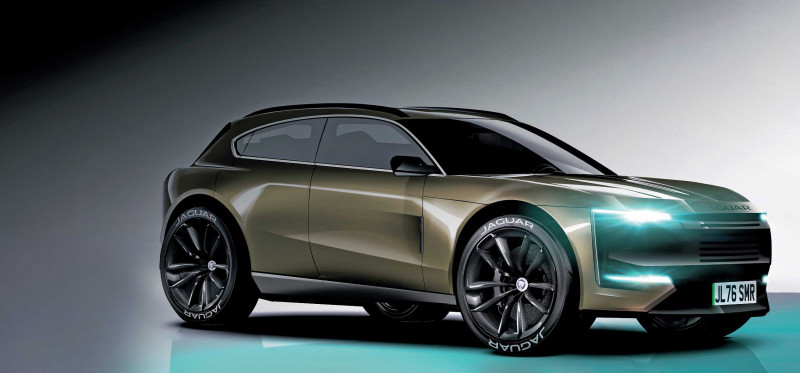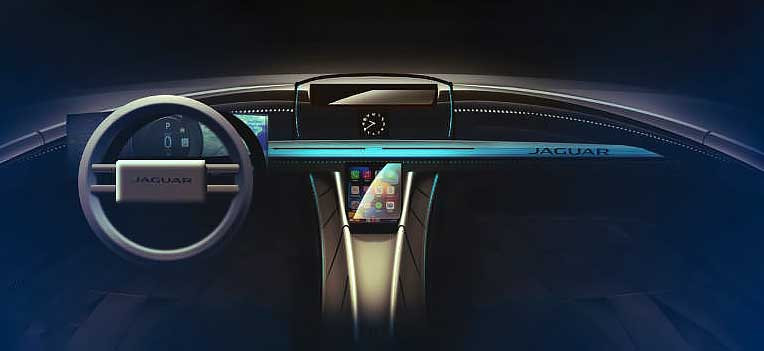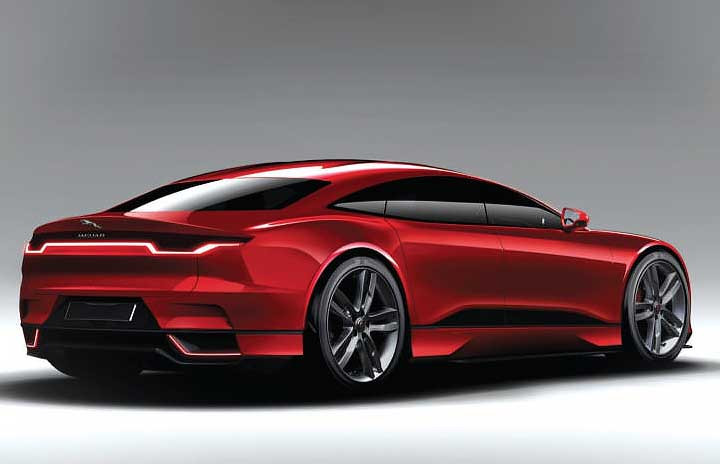Jaguar reimagined axed XJ EV as lavish limousine
Jaguar limo – all-new ‘XJ’ in radical fresh-start EV trio. All-new large saloon to join reborn luxury brand’s three-strong electric line-up beside GT and SUV.
SHOK NEW JAG – EXCLUSIVE – Luxury limo to spearhead brand’s reinvention
THE CARS SPEARHEADING JAGUAR’S REBOOT
Jaguar is preparing to launch a large, lavish electric saloon to serve as an indirect replacement for the axed XJ EV, Autocar can reveal. It was previously understood that Jaguar’s new four-seat grand tourer, launching in 2025, would be followed into dealerships by a pair of luxury crossovers. But now a source familiar with the new models has told Autocar that while one of the other two cars is indeed a Bentley Bentaygasized flagship SUV, the other is actually an imposing limousine conceived in the mould of the XJ, albeit heavily redesigned, substantially larger and much more luxurious.

All three cars will sit on the long-wheelbase JEA electric vehicle platform being developed exclusively for use by new-era Jaguar models. Talking recently to Autocar, JLR CEO Adrian Mardell said the Jaguar brand needed its own architecture: “Otherwise, it doesn’t quite look as potent and exuberant as you would wish it to. This wheelbase and this architecture will deliver the design intent.”
Priced from between £100,000 and £125,000, the three cars will come equipped with four-wheel drive, four-wheel steering and ultra-fast charging capacity that will allow for a 10-80% top-up time of just 13 minutes. Early details suggest each will produce no less than 450bhp, sprint from 0-62mph in between 3.0sec and 3.8sec, top out at 155mph and offer ranges of at least 385 miles and up to 475 miles.

Before ex-JLR CEO Thierry Bolloré’s Reimagine plan was introduced, Jaguar had been developing an electric XJ that was based on the Range Rover’s MLA platform and originally due for launch by 2022. But the project was scrapped when the car was deemed incompatible with the wider plan for Jaguar.
That car has never been revealed, and Jaguar had given no indication of its performance potential before the programme was halted in 2021. It’s likely, however, that its replacement’s impressive figures are only possible because of significant advancements in battery, motor and charging hardware in the intervening years.
Not only will they make the new electric saloon immediately one of the most advanced cars in its segment when it is launched, but they should also ensure that the model remains at the cutting edge until the next step-change in the development of electric drivetrain technology.
Autocar’s source said the saloon and its range-mates are unrelated to every car Jaguar has launched so far and bear little resemblance to the artists’ impressions that have been circulating since the brand’s reinvention plans were first made public.
Perhaps most surprising of the details obtained by Autocar is that the new models no longer bear the leapingcat emblem that has adorned most of the Coventry-based firm’s cars since the end of the Second World War. Instead, the Jaguar name will be spelled out across the front and rear in a new font, which is emblematic of the granular approach that bosses are taking with the brand’s reinvention programme. Chief creative officer Gerry McGovern’s pledge that the cars will be “a copy of nothing” (itself based on a quote by Jaguar founder Sir William Lyons) is clearly being followed to the letter.
Mardell recently told Autocar that all current Jaguar models will have to come off sale by 2025 because they will look nothing like their replacements. “When we launch our new JEA platform, the change from today on Jaguar is very dramatic,” he said. “We don’t want older-looking cars and newer-looking cars.”
To that end, the silhouette of each new Jaguar will be a radical departure from that of even its most closely related predecessor. For example, while the large electric limousine at the heart of the proposed three-strong model range is best thought of as a spiritual successor to the XJ, it won’t ape the swooping three-box shape shared by each of that car’s five generations. Instead, Autocar’s source indicates that it will adopt a radically minimalist new look with no obvious inspiration from any model past or present.
Described as comparable in size to the Bentley Mulsanne – which was 5575mm long as standard – the new saloon will have a low-slung silhouette defined by sharp surfacing and generous proportions.
The flat front end will host ultra-slim LED headlights arranged in a distinctive new pattern around a non-functional grille-style structure that will come to be known as the new face of Jaguar. It will be joined at a near-90deg angle to an expansive, probing bonnet that’s said to be longer than that of any previous Jaguar.
Other defining features of both the saloon and its GT and SUV stablemates include a ‘floating’ roof effect achieved by black A- and B-pillars, striking 22in alloy wheel designs and a range of overtly luxurious paint options including brushed gold and silver.
The tail-lights, meanwhile, are said to be integrated into ultra-thin slits that run across the wide-arched rear end and will be ‘invisible’ when the cars are turned off, as is the case with the latest Range Rover.
None of the three cars will feature a rear window, in a move mirroring that of Swedish EV maker Polestar. Rear visibility will instead be provided by a digital ‘mirror’ screen at the base of the windscreen, while smaller screens at the base of the A-pillars will replace conventional side mirrors.
The minimalist design theme carries over to the interiors of the new cars, which major on advanced technology, spaciousness and upmarket materials (including vegan-friendly upholstery options) – although individual differences for each model remain to be seen.
At this stage, it’s understood that the saloon only has buttons on the steering wheel, with a slick wraparound digital display behind the steering wheel serving as the main infotainment interface. A smaller touchscreen on the centre console, meanwhile, handles key functions such as the climate control and audio.
The centre console will either extend through the length of the cabin to divide the rear seat into two separate areas or be of a shortened design to give a more conventional five-seat layout. In keeping with Jaguar’s shift upmarket, rear-seat passengers will get USB-C charging ports, individual infotainment screens on the back of the front seats and blinds for the rear windows and reclining seats, as well as generous amounts of leg, head and elbow room, aided by the car’s substantial footprint. It’s not yet known whether the related GT model, which is described as a sporting version of the saloon, will trade some of that capaciousness and luxury appeal in pursuit of a tighter, sleeker silhouette and a more obvious focus on performance, but the SUV at the top of the line-up will no doubt offer space and opulence on a par with those of its Bentley rival.
JLR’s goal is for the revived Jaguar brand to sell 4000 cars a month globally. To achieve that, based on the much higher pricing structures it will introduce, its cars must be designed to appeal to buyers in emerging luxury car markets. Mardell explained: “North America, UK, Europe: these are regions where Jaguar has sold well in the past, and they will sell well there again, and we have China, which we’ve never broken through, and Jaguar never relied on, but which we’re now starting to understand. “We’ve got people in China researching and sharing their views on those vehicles, so they can actually tell us whether they think those vehicles can be successful within China, and we’re delighted with their response.”
Jaguar’s four-door GT will be shown late next year before going on sale in 2025. The firm hasn’t hinted at arrival dates for its range-mates, but it will launch no more than one car per year after the first.
Minimalist interiors will centre on touchscreens, use sustainable materials.
The SUV will offer space and opulence on a par with its Bentley rival
MODERN YET TRADITIONAL
FELIX PAGE
This news is the most concrete indication yet that Jaguar’s new family of electric vehicles really will be the embodiment of ‘modern luxury’.
Indeed, they will have to be. The saloon uncovered by Autocar, for example, will go toe-to-toe with some of the most deeply impressive electric limousines on sale and be priced to match. Plus, it won’t be able to hide behind established Jaguar brand cachet and reputation, because clearly the firm has no intention of drawing on any of that.
Traditionalists may bemoan the extinction of buttons, the LED lovein and the advent of topdrawer connectivity tech, but above all Jaguar is a brand so intrinsically linked with saloons that surely the emergence of another can only be cause for celebration.
‘MODERN LUXURY’ KEY TO JLR’S RETAIL FUTURE
Jaguar’s reinvention programme involves removing the brand from certain JLR dealerships worldwide. The move is being made in line with the new ‘House of Brands’ approach to carving each existing model line – Jaguar, Range Rover, Discovery and Defender – into a brand in its own right. “You don’t need to cram a vehicle in at a dealership with 20 vehicles,” said JLR CEO Adrian Mardell of the move to a more intimate showroom arrangement that will have some dealerships narrow their focus to specific brands. “I would argue that’s not ‘modern luxury’. When you’re walking around a dealership, you don’t want to be squeezing between two bumpers.
“We’re going to be much more bespoke about how we show our brands. We’re going to have Range Rover houses, we’re going to have Jaguar houses, maybe we have a Defender house and a Discovery house. Maybe some outlets will have all of the Land Rover brands.”
JLR has previously said its shift to an agency model – whereby it will move away from franchising dealers to take direct control of the retail process – will foster a “much warmer, much more hospitable and much more relaxed” buying experience. Some sites will close as part of this process, although it hasn’t been confirmed how many, and it remains to be seen what physical footprint the Jaguar brand will retain. More intimate ‘bespoke’ showrooms will become the norm for Jaguar.

‘Old’ XJ replacement was close to being production-ready before being canned.
Jaguar won’t look back at its heritage to inform its new models.
New limousine will be a de facto XJ replacement but larger and more luxurious.
SPY SHOTS
The electric XJ was in the final stages of public-road testing before being axed in 2021 by previous JLR CEO Thierry Bolloré. It was a “very tough decision”, he said, made in light of the move to a bespoke architecture and a significant step upmarket.


